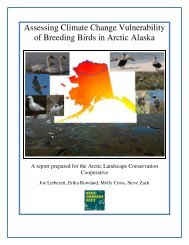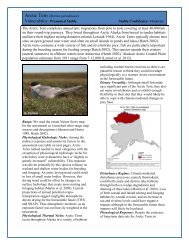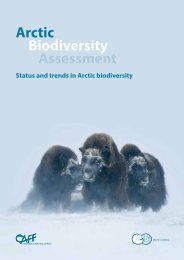Permafrost Terrain Stability and Thermokarst Monitoring: - Arctic LCC
Permafrost Terrain Stability and Thermokarst Monitoring: - Arctic LCC
Permafrost Terrain Stability and Thermokarst Monitoring: - Arctic LCC
Create successful ePaper yourself
Turn your PDF publications into a flip-book with our unique Google optimized e-Paper software.
46. Grosse, G., Schirrmeister, L., <strong>and</strong> Malthus, T.J., 2006, Application of L<strong>and</strong>sat‐7<br />
satellite data <strong>and</strong> a DEM for the quantification of thermokarst‐affected terrain types in<br />
the periglacial Lena–Anabar coastal lowl<strong>and</strong>: Polar Research, v. 25, no. 1, p. 51–67.<br />
This paper describes the use of L<strong>and</strong>sat-7 satellite data <strong>and</strong> a digital elevation model for the<br />
quantification <strong>and</strong> description of an approximately 3,500-km 2 thermokarst-affected region<br />
in northern Siberia. A supervised classification approach was used to determine various<br />
thermokarst l<strong>and</strong>forms that relied primarily on relief forms <strong>and</strong> the spectral response of<br />
various tundra vegetation types. The final terrain type classification was composed of eight<br />
major classes (seven l<strong>and</strong> classes <strong>and</strong> one water class). These were divided into 37<br />
subclasses, <strong>and</strong> the class composition for some of these subclasses was categorized based on<br />
thermokarst depressions, pingos, river valleys, thermo-erosional valleys, <strong>and</strong> yedoma<br />
upl<strong>and</strong>s. Thirteen surface classes ultimately were determined to provide good overall<br />
classification accuracy (79 percent), <strong>and</strong> that 78 percent of the study area was affected<br />
somewhat by thermokarst, thermo-erosion, <strong>and</strong> related slope processes.<br />
47. Harris, C., <strong>and</strong> Lewkowicz, A.G., 2000, An analysis of the stability of thawing slopes,<br />
Ellesmere Isl<strong>and</strong>, Nunavut, Canada: Canadian Geotechnical Journal, v. 37, no. 2,<br />
p. 449–462.<br />
This paper examined the potential for failure of two slopes showing evidence of previous<br />
active layer detachment slides. Theoretically, detachment failures depend on soil <strong>and</strong> pore<br />
pressures. By measuring soil pore pressure <strong>and</strong> active layer depths, the authors were able to<br />
calculate the safety factor for the given slopes, <strong>and</strong> to estimate the pore pressures needed to<br />
facilitate a detachment slide. Although the tested slopes were in relatively safe states,<br />
changes necessary to induce slides were calculated. Depth of saturation <strong>and</strong> buried s<strong>and</strong><br />
layers were recognized as two potentially important factors. Shear strength was identified as<br />
the most sensitive parameter controlling slope stability; shear strength may decrease<br />
annually when active layers are deep, eventually weakening the soils <strong>and</strong> allowing slides to<br />
occur.<br />
48. Harris, S.A., 2002, Causes <strong>and</strong> consequences of rapid thermokarst development in<br />
permafrost or glacial terrain: <strong>Permafrost</strong> <strong>and</strong> Periglacial Processes, v. 13, no. 3,<br />
p. 237–242.<br />
This paper compares air, soil, <strong>and</strong> water temperature at one location to show that heat is<br />
adsorbed differently by soils <strong>and</strong> water. A lag time between water temperature <strong>and</strong> ground<br />
temperature was observed, <strong>and</strong> a large disconnect during cooling was noted when winter<br />
temperatures reached -3°C <strong>and</strong> -19°C in the lake <strong>and</strong> the ground, respectively. The<br />
subsurface inflows could have affected the comparison. Discussion focuses on the major<br />
differences between soil <strong>and</strong> water, including heat capacity, thermal diffusivity, <strong>and</strong> thermal<br />
conductivity. Translucency <strong>and</strong> convection are two important factors that are unique to<br />
water <strong>and</strong> heat storage <strong>and</strong> exchange. The discussion notes how the differences in thermal<br />
properties of water <strong>and</strong> soils may lead to thermokarst development <strong>and</strong> shows photographs<br />
representing the formation of an alas valley.<br />
18








